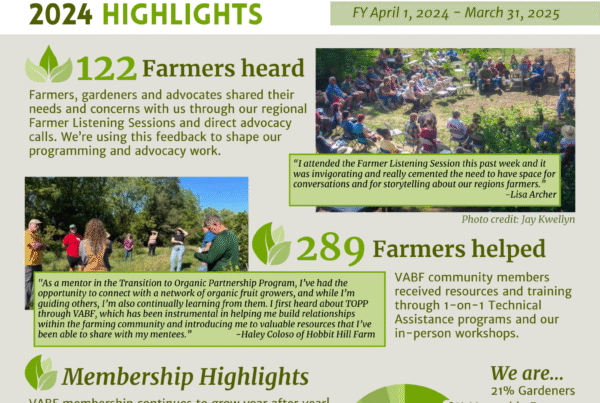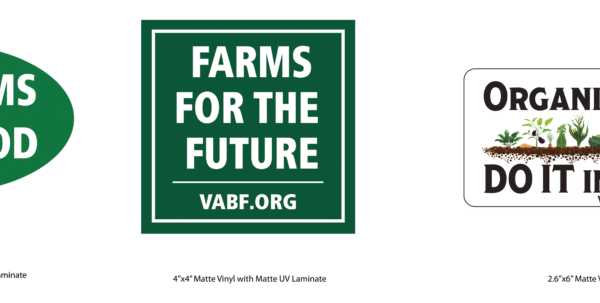From Mark Schonbeck
Dear All,
 Remember last year’s all-out grassroots campaign, spearheaded by the National Sustainable Agriculture Coalition (NSAC) to submit comments to the US Food and Drug Administration (FDA) on their proposed rules for the Food Safety Modernization Act (FSMA)? Remember how hard we worked to ensure that the new food safety rules don’t put family farms out of the produce business and don’t slow the growth and evolution of sustainable local food systems? While thousands of us in the field wrote individual comments from farmer, processor, and consumer viewpoints, the NSAC Food Systems Integrity Committee also stayed in close dialogue with FDA on the issues, and many NSAC member groups, including VABF, submitted comments on behalf of their constituencies.
Remember last year’s all-out grassroots campaign, spearheaded by the National Sustainable Agriculture Coalition (NSAC) to submit comments to the US Food and Drug Administration (FDA) on their proposed rules for the Food Safety Modernization Act (FSMA)? Remember how hard we worked to ensure that the new food safety rules don’t put family farms out of the produce business and don’t slow the growth and evolution of sustainable local food systems? While thousands of us in the field wrote individual comments from farmer, processor, and consumer viewpoints, the NSAC Food Systems Integrity Committee also stayed in close dialogue with FDA on the issues, and many NSAC member groups, including VABF, submitted comments on behalf of their constituencies.
Well, our work has paid off. FDA heard us and went back to the drawing board and reworked key sections of the Produce Rule (which regulates produce farms), and the Preventive Controls Rules (which regulates food processing businesses). This fall, FDA issued its “second draft” – a re-proposal of these sections of the rules. It is fairly unusual for a federal agency to issue a second proposed rule, and indicates that FDA wants to work with us to ensure that the rules protect food safety and are workable for producers and processors at all scales.
The re-proposal makes a substantial improvement over the first proposed rule. However, much more work needs to be done to ensure that the rules and their implementation do not impose excessive costs on small farms and businesses, and do not create unwarranted barriers to conservation, ecological farming practices, and the growth of local sustainable food systems.
We need farmers, processors, and consumers of organic / sustainable / local food to give their input to FDA between now and December 15!
Below are links to several documents that can help you develop your comments and inform/engage others in this vital campaign:
- Commenting instructions, including how to submit your comment on line or via US post (Word document)
- A handy flyer (PDF document) to use to inform others (such as CSA members, farmers market customers, etc) about the FSMA and the current comment period.
- A comments template for consumers
- A comments template for farmers, that includes more information on key issues.
- A useful flow chart for knowing how the new FSMA rules could affect you and to help develop comments for the FDA
For more information on FSMA, visit NSAC’s web page on FSMA, http://sustainableagriculture.net/fsma, which includes links to:
- An overview of FSMA history and current status
- In-depth information and analysis of specific issues and how the 2014 re-proposed rules address them are at, each of which is summarized below (after my signature).
Thank you – and I apologize for the short time line and my tardiness in getting this out to you all.
Sincerely,
Mark Schonbeck
VABF newsletter editor and policy liaison
Additional Information Regarding FSMA Rules
Specific remaining issues that must be addressed in the final FSMA
rules include:
- In the re-proposed rules, FDA definitions of “farm” and farm activities such as harvesting, packing, and holding, still have the potential to limit farmers’ ability to expand local food systems through aggregation, food hubs, farm-to-school programs, etc. For example, a group or cooperative of farmers who operate a shared packing and holding facility would be reguated as a “facility” under the Preventive Controls Rule, even though the new proposed rules recognizes these as low-risk activities that are considered part of a “farm” when conducted on farm. This can pose a substantial barrier to innovative farmers developing new models for expanded local food systems that bring more revenue and deliver fresh high quality food to a higher percentage of community residents. In addition, FDA still defines a “farm” as “in one general physical location,” which could be interpreted to treat farmers who own and operate two non-contiguous properties as operators of “facilities” subject to both Rules. FDA definitions must be clarified and broadened in order to remove unwarranted barriers to low-risk aggregation, packing,and holding activities that are essential to the growth of local food systems.  For more on this issue, visit the NSAC page on operating a farm/facility.
- Annual sales thresholds used to determine whether a farm is exempt from the FSMA rules ($25,000) or can meet a simplified set of requirements (“qualified exemption, $500,000); and to determine the regulatory approach for food facility businesses, are variously based on “all produce,” “all human food,” or a”all food,” which creates confusion as well as barriers to farm diversification. For example, a farm producing over $500,000 annually in products not covered by FSMA that seeks to diversify into covered produce (e.g., salad greens, strawberries) would have to comply with the full Produce Rule, even if the covered produce sales are within the exemption or qualified exemption thresholds. The cost of such compliance would likely make the divesification economically infeasible. We are asking FDA to base exemption thresholds for the Produce Rule on sales of covered produce, and thresholds for the Preventive Controls Rule on sales of food items covered by this Rule.  For more on this issue, visit the NSAC food covered product page.
- The re-proposed rule still fails to clarify that CSAs, CSA drop-off points, multi-farm CSA’s, farmers’ markets, farmstands, and other direct-to-consumer venues are not “facilities” but are “retail food establishments not subject to the Preventive Controls Rule. We need to push FDA to include this simple clarification, which is mandated in the FSMA legislation itself, in the final rule. For more on this issue, visit the NSAC direct to consumer page.
- In a positive development, FDA dropped the 9-month interval between application of uncomposted manure and harvest, and the 45 day interval between compost application and harvest, and are instead planning to research the manure issue in order to develop a more science-based application interval. Ath this time and throughout FDA’s process of researching and developing proposed regulations for “soil amendments of animal origin”, it is vital that producers provide input to FDA regarding the importance of compost and/or manure in their nutrient management and soil improvement practices, and how they manage and use these materials to protect food safety while providing needed fertility.  For more on this issue, visit the NSAC page on manure and compost.
- Regarding the re-proposed rule still fails to recognize that many conservation practices, such as riparian buffers and beneficial habitat plantings can also help protect produce safety in crop production fields. They do not encourage implementation of these conservation practices, and could still deter farmers from installing conservation plantings. In the final rule, FDA needs to define “co-management” of conservation and food safety concerns and encourage implementation of win-win conservation plantings and practices. In addition, FDA needs to clarify that its deferral of the 9-month manure rule also means that a 9-month interval between grazing a field and the next food harvest is not required. For more on these issues, visit the NSAC page on conservation and on animals.
- Regarding the use of surface water for irrigation of produce crops, the re-proposed rule offers greater flexibility, but it still requires a costly and burdensome water testing protocol without adequate scientific justification. One of the positive aspects of the new rule is that it assumes that bacteria in applied water undergo a ten-fold (one log unit) dieoff every two days; thus a water source that somewhat exceeds standards can be used if applied a sufficient number of days before harvest so that die-off brings it within the standard. We need producers to let FDA know how the current proposed water standards would impact their operation, and how the standard might be modified to reduce testing costs while still adequately protecting food safety.  For more on the water issue, visit the NSAC page on agricultural water.
- Although farms with annual sales under $500,000 and food facilities with annual sales under $1 million may qualify for modified (simplified) compliance requirements (also called “qualified exemption”), FDA retains broad authority to revoke the qualified  exemption and subject the farm or facility to the full regulation if they think there is a food safety problem. While the re-proposed rule has improved the process and includes a route for producers and processors to regain the qualified exemption upon correcting the problem, the rules remain sufficiently vague and inconsistent that they do not protect farmers from unfair and arbitrary revocations of the qualified exemption. For example, the “material conditions” on which a revocation might be based remain inadequately defined. We need to push FDA to establish a clear, fair, and consistent process for alerting qualified-exempt producers of a potential problem and how they can correct it, as well as for suspension and reinstatement as appropriate.  For more on exemptions and modifications, visit the NSAC page regarding the Produce Rule and/or the page regarding Preventative Controls for facilities.
- The re-proposed Preventive Controls Rule requires facilities to implement “supplier verification programs” for certain foods, which could entail an on-side audit for farms who are already complying with the Produce Rule. This provision imposes an additional burden on farmers who want to sell to a food processing facility, and it also conflicts with the statutory language of FSMA. For more on this issue, visit the NSAC page on supplier approval and verification.
- Estimated costs of compliance with the Produce rule and Preventive Controls rule remain high enough that FDA anticipates that some small farms and facilities may go out of business, fewer people will start farming, and more farmers will have to seek off-farm income. The added costs of entering produce farming could have a particularly severe impact on beginning farmers In addition, the re-proposed Preventive Controls Rule includes two new and costly requirements: environment testing (food prep surfaces, etc), and product testing. FDA must find ways to reduce costs of compliance, and at least make the new environment and product testing “guidance” and not regulation.  For more on these issues, visit the NSAC page on Environmental and Product Testing, or on costs to facilities of on cost to produce farmers.
- FDA is requesting comment on how much record keeping should be required of farmers who pack and hold produce from other farms. Farmers should not be required to keep any more detailed records than they normally would in the course of doing business, such as invoices showing produce purchases and sales.  For more on these requirements, visit the NSAC page on record keeping requirements.







